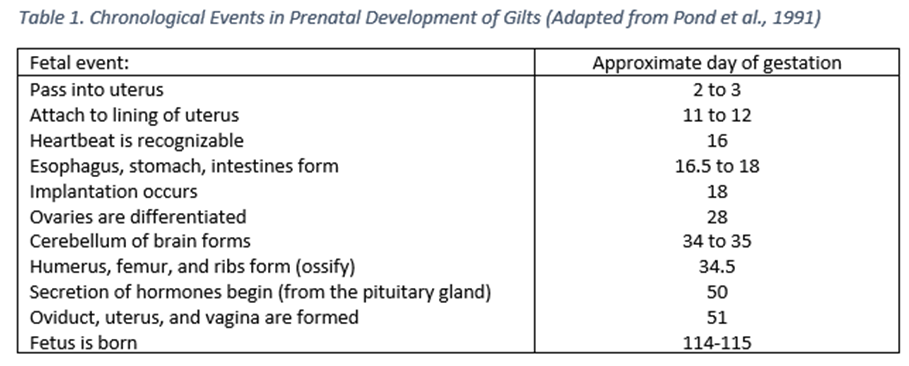



Minding your gilts' prenatal environment
The lifelong performance of pigs is known to be affected by conditions during gestation (uterine) and early life (neonatal, 21 days after birth). Adverse conditions and stressors during gestation or nursing can have a negative impact on a gilts performance during their lifetime and can even be carried over to future generations (Ji et al. 2016).by Pius B. Mwansa, PhD
Fetal or prenatal programming, as the concept is commonly referred to, is an important consideration in modern pork production (Foxcroft et al. 2006 and Ji et al. 2017). Researchers are examining the causes and effects of prenatal programming and what defines the optimum gestation and nursing environment (temperature, stressors, nutritional, etc.) of gilts to maximize their reproductive efficiency.
For example, litter size in which gilts are raised impacts the size of the litters that they themselves produce (Nelson and Robison, 1976). In 2007, O’Gorman et al. demonstrated the concept of prenatal programming with an experiment in which gestating sows were allocated to control or stressed treatments.
“Stressed” sows were subjected to daily restraint for five minutes during weeks 12 to 16 of gestation. Age at first estrus was significantly delayed in gilts farrowed by stressed sows (172 + 6 days) compared to gilts farrowed by control females (158 + 2 days).
Prenatal development of pigs is ordered and structured and when a “gestational stress” occurs can have different impacts on the piglets. Table 1, shows selected stages of the development of the pig fetus. A stressor occuring during any of these uterine developmental stages can permanently affect the performance of gilts resulting from the affected litter.
An “optimized” feeding and management program throughout the gestation period helps create a prenatal environment for the developing fetuses and lessens the associated detrimental effects from gestational stress.
Genesus’ uses in-house and cooperating partners’ knowledge to develop sow genetic, nutrition and management programs that support customers achieving superior performance and maximized profitability. Continual R&D investment and implementation has propelled Genesus into a leading global supplier of superior swine genetics.
References
Foxcroft G. R., W. T. Dixon, S. Novak, C. T. Putman, S. C. Town, and M. D. A. Vinsky. 2006. J. Anim. Sci. 84(E. Suppl.):E105–E112.
Ji, Y., Z. Wu, Z. Dai, K. Sun, J. Wang and G. Wu. 2016. J. Nutr. Biochem. 27:1-8.
Ji, Y., Z. Wu, Z. Dai, X. Wang, J. Li, B. Wang and G. Wu. 2017. J. Anim. Sci. and Biotechnology. 8:42. DOI 10.1186/s40104-017-0173-5.
Nelson, R.E., and O.W. Robison. 1976. J. Anim. Sci. 43:71-77.
Pond, W.G., J.H. Maner, and D.L. Harris. 1991. In: Pork Production Systems: Efficient Use of Swine and Feed Resources. Van Nostrand Reinhold, New York, NY.










